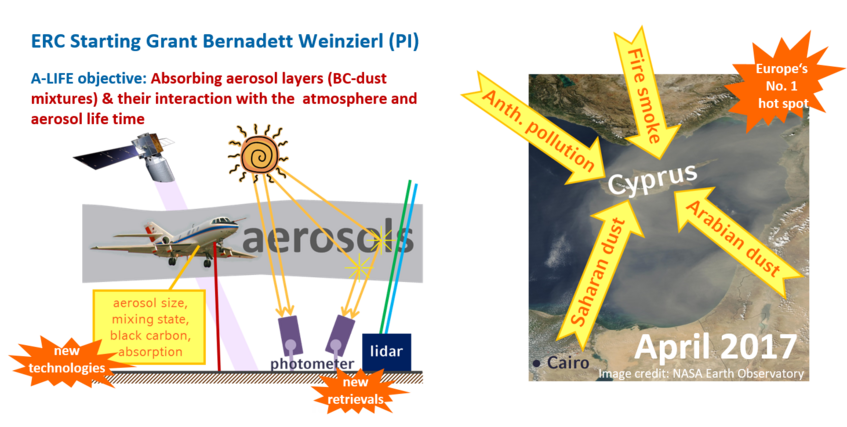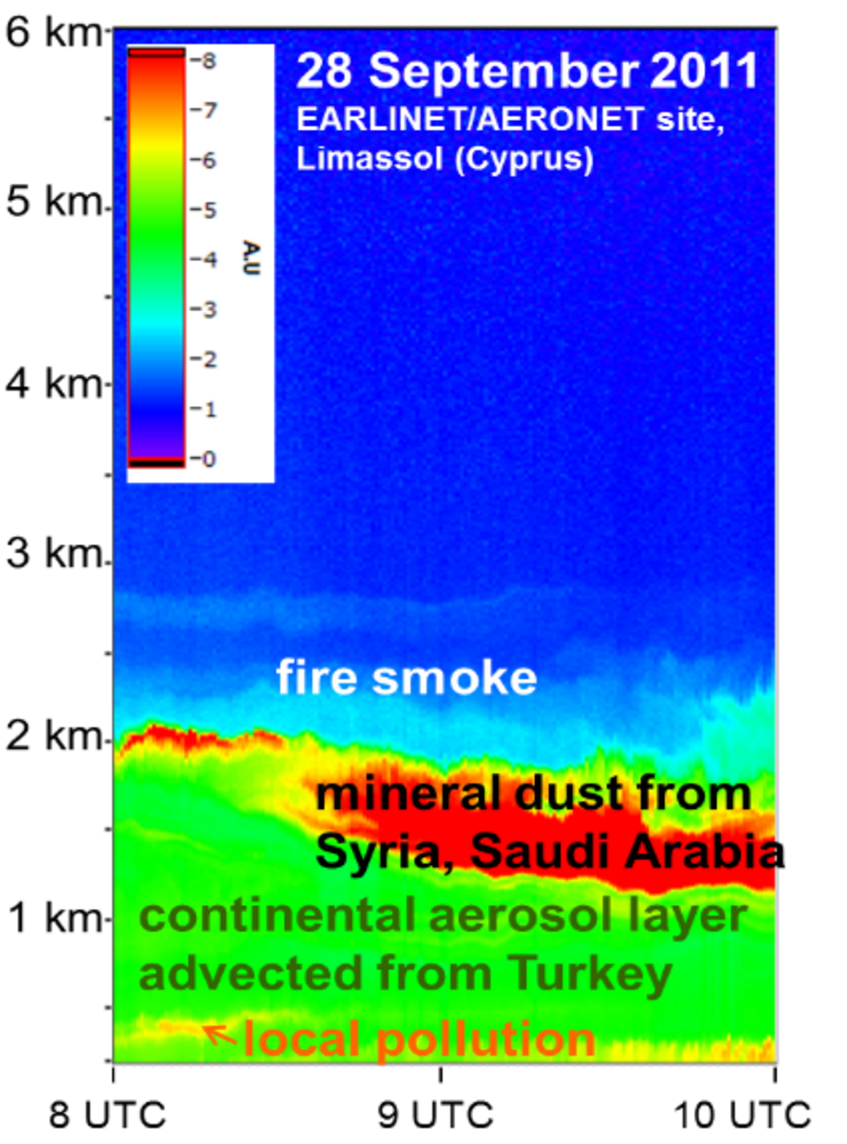
A-LIFE
Absorbing aerosol layers in a changing climate: aging, lifetime and dynamics (A-LIFE)
A-LIFE is an ERC project at the University of Vienna with PI Bernadett Weinzierl.
Project start: 1 October 2015
Project duration: 5 years
This project has received funding from the European Research Council (ERC) under the European Union’s Horizon 2020 research and innovation programme under grant agreement No. 640458.
Project Overview
Aerosols (i.e. tiny particles suspended in the air) are regularly transported in huge amounts over long distances impacting air quality, health, weather and climate thousands of kilometers downwind of the source. Aerosols affect the atmospheric radiation budget through scattering and absorption of solar radiation and through their role as cloud/ice nuclei.
In particular, light absorption by aerosol particles such as mineral dust and black carbon (BC; thought to be the second strongest contribution to current global warming after CO2) is of fundamental importance from a climate perspective because the presence of absorbing particles (1) contributes to solar radiative forcing, (2) heats absorbing aerosol layers, (3) can evaporate clouds and (4) change atmospheric dynamics.
The overall aim of A-LIFE is to investigate the properties of absorbing aerosols (in particular mineral dust – black carbon mixtures) to (1) characterize the aging and mixing of light-absorbing aerosol layers during their lifetime, to (2) assess the contribution of individual aerosol components, in particular mineral dust and BC to the radiative forcing (RF) of mixed absorbing aerosol layers, to (3) implement complex particle morphologies in RF estimates, and (4) to investigate potential links between the presence of absorbing particles, aerosol layer lifetime and removal.
To achieve the aims of A-LIFE, an innovative aircraft field experiment is conducted in the Eastern Mediterranean between 3 and 30 April 2017 (aircraft base: Cyprus), and the field data are combined with laboratory and modelling studies.
Figure 1. Left: The A-LIFE initiative combines airborne, ground-based and satellite observations to study the properties of absorbing aerosols in the Eastern Mediterranean. Right: Target area for the A-LIFE field experiment is the Eastern Mediterranean. The yellow arrows indicate air transport patterns in the Eastern Mediterranean throughout the different seasons.
The outcome of A-LIFE will provide fundamental new understanding of absorbing aerosol layers in the climate system and important information for addressing the benefits of black carbon emission controls for mitigating climate change.
Funding
This project has received funding from the European Research Council (ERC) under the European Union’s Horizon 2020 research and innovation programme under grant agreement No. 640458 (A‐LIFE). In addition, the German Aerospace Center (DLR) provided funding for a significant amount of flight hours and aircraft allocation days for the A-LIFE aircraft field experiment. Furthermore, two EUFAR projects were clustered with A‐LIFE and provided funding for 16 flight hours. Moreover, various groups participated in the A‐LIFE field experiment on their own funding.
Cooperation
(see: Partners)
A‐LIFE (PI: Bernadett Weinzierl, University of Vienna, Austria) involves partners from several European countries and the U.S. including the University of Vienna (UNIVIE, Austria), the German Aerospace Center (DLR, Germany), Institute for Tropospheric Research (TROPOS, Germany), Ludwig‐ Maximilians‐Universität (LMU, Germany), University of Natural Resources and Life Sciences (Boku, Vienna, Austria), Technical University of Darmstadt (Germany), University of Valladolid (Spain), EnviTech (Budapest, Hungary), National Oceanic and Atmospheric Administration (NOAA, USA), Karlsruhe Institute of Technology (KIT, Germany), TU Vienna (TU Wien, Austria), Austrian Weather Service (ZAMG, Austria), National Observatory of Athens (NOA, Greece), University of Crete (Greece), Cyprus University of Technology (Cyprus), University of Hertfordshire (UK), The Cyprus Institute (Cyprus), Institute of Physics Belgrade (Serbia).
We would like to thank EDT Hangar Services for hosting us during the A‐LIFE field phase in Paphos (Cyprus).
References
IPCC (2013), Book Climate Change 2013: The Physical Science Basis. Contribution of Working Group I to the Fifth Assessment Report of the Intergovernmental Panel on Climate Change Cambridge University Press, Cambridge, United Kingdom and New York, NY, USA.
Media
Report about A-LIFE (UNI:VIEW Magazin, in german):
http://medienportal.univie.ac.at/uniview/forschung/detailansicht/artikel/staubige-luft/



